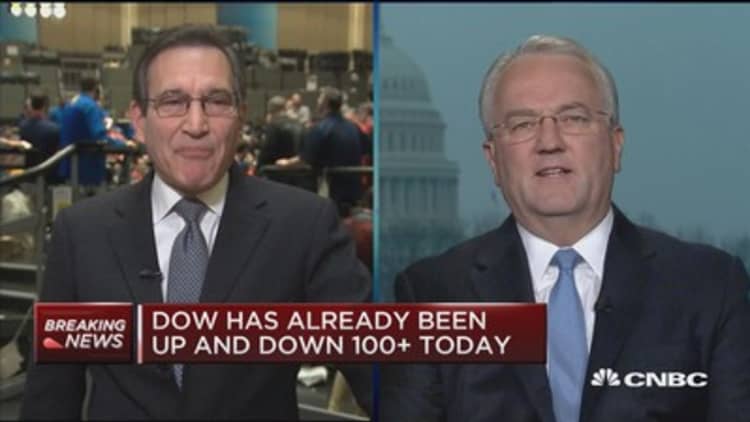Oil prices fell for a fourth straight session on Wednesday after government data showed U.S. crude and fuel stockpiles rose last week, while American drillers continue to increase production.
"The report was unilaterally negative — not only did it show builds in both crude and refined products, but what spooked the bears is that U.S. production hit a fresh record high of 10.25 million" barrels per day, said Tamar Essner, director of energy and utilities at Nasdaq Corporate Solutions.
U.S. West Texas Intermediate (WTI) crude futures ended Wednesday's session down $1.60, or 2.5 percent, to $61.79 a barrel. The contract hit one-month closing and intraday lows and was trading down 5.6 percent this week.
Brent crude futures fell $1.35, or 2 percent, to $65.51 a barrel, closing below its 50-day moving average for the first time in about seven months. The contract has not fallen below $66 a barrel since Dec. 26 and is down 4.5 percent for the week.
Crude futures were caught up in a broad market sell-off earlier in the week. But while U.S. share prices continued to rally after a late afternoon rebound on Tuesday, oil prices extended losses after the weekly inventory report.
U.S. commercial crude inventories rose by 1.9 million barrels to 420.3 million in the week through Feb. 2, the U.S. Energy Information Administration reported.
That was lower than the increase of roughly 3 million barrels analysts anticipated in a pair of surveys. But data on Tuesday from the American Petroleum Institute had shown a decline of 1.1 million barrels, setting market expectations for a drop after the previous week's big rise.
The increase was largely due to a buildup of stockpiles in the Gulf Coast refining hub, where refiners are winding down operations for seasonal maintenance.
Despite this, refinery activity remained strong, but last week's data likely did not reflect some big shutdowns, said Tom Kloza, global head of energy analysis at Oil Price Information Service.
"We're going to see those refinery runs drop next week and they'll continue to drop into March," he said. "Ultimately that means somewhere after President's Day and after the Olympics we're going to see a gasoline rally, but not yet."
Stockpiles of gasoline and distillate fuels such as diesel also rose by 3.4 million barrels and 3.9 million barrels respectively, EIA reported, surpassing expectations by a wide margin.
The U.S. dollar index rose back above 90 cents, piling further pressure on commodities, said John Kilduff, partner at energy hedge fund Again Capital.
The correlation between the dollar and oil has recently reasserted itself. A stronger greenback makes commodities sold in dollars more expensive to buyers who hold other currencies.

Also on Wednesday, the operator of Britain's most important oil and gas pipeline announced automated safety systems had shut the 450,000 barrel-per-day system due to an undisclosed issue.
The company, Ineos, said it aims to restart the pipeline overnight, but the incident marks the second time in two months the system, which transports North Seas Forties crude, has shut.
Surging U.S. production threatens to offset the impact of OPEC's deal with Russia to keep 1.8 million barrels a day off the market through 2018. The goal of the production caps is to shrink crude inventories in developing nations.
The EIA's preliminary figures showing production at 10.25 million barrels a day was telegraphed by last week's report that November output rose above 10 million barrels a day for the first time since 1970.
On Tuesday, EIA forecast U.S. production will average 10.6 million barrels a day this year, enough to continue surpassing output from Saudi Arabia, until recently the world's second-biggest producer. In 2019, EIA sees American output at 11.2 million barrels, enough to rival top producer Russia.
Analysts warned that oil market moves could be exaggerated because the number of bets that crude prices will keep climbing has risen sharply, while wagers that prices will fall have plunged. That extreme market positioning can encourage bouts of profit-taking.


